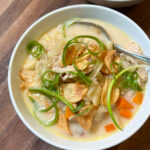Curry Udon is a hearty and flavorful noodle dish that combines the best of rich Japanese curry with thick, chewy udon noodles.
Recipe Rundown
Taste
This curry udon has the classic umami, savory, and rich Japanese curry along with bouncy and chewy udon noodles for a filling meal.
Japanese curry blocks
For ease, we’ll be using the store-bought Japanese curry blocks that already come with the curry seasoning and a thickener to make our sauce. You may also use standard curry powder in a pinch (such as the Japanese S&B brand).
Protein
To speed up the cooking process, use thinly-sliced beef such as rib-eye, sirloin, or chuck. You may also substitute the beef with chicken, turkey, shrimp, ground meat, or even tofu!
Quick Tips
Customize your curry: Add chili flakes to add a little heat. Pour in a splash of coconut milk for extra creaminess. You may also add more vegetables, such as potatoes and carrots, to make the dish even more hearty.
What is Curry Udon?
Curry udon combines chewy, thick udon noodles with a classic Japanese curry.
In general, Japanese curry is typically sweeter, with a thick consistency -making it perfect for coating the noodles with.
For this version of curry, I opted for the Japanese curry cubes. Also known as Japanese curry roux, these are normally blocks of curry (typically varying in their levels of spiciness) with starch or flour in them, working as a thickener.

These are immensely convenient, as you simply just need to throw them into a pot of stock and you’ll have a thick, glossy curry ready in just 10 minutes!
There are ways to make this without using the curry cubes, however. You can also use standard curry powder, but I’d recommend thickening up the sauce with some sort of cornstarch slurry so that it can cling onto the noodles better (more information on that in the Ingredients section!)
Ingredients and Substitutions
Udon: Go for the frozen, “sanuki udon” blocks, typically found in the frozen section of most Asian groceries. These are chewier and more bouncy than the dried udon or the ones that come vacuum-packed.
- Substitutions: If you can’t find the frozen udon, you can also go for the dried udon or the ones packed in plastic. While not exactly the same, other noodle variants you could try with this recipe include ramen, shiritaki, or soba noodles.

Onion, garlic: Fresh aromatics are always best for any curry to allow them to break down into the sauce.
- Substitutions: You could also use powdered onion and garlic, in a pinch. 1/4 teaspoon of each should work just fine.
Thinly-sliced beef: Go for the beef typically used for hotpot or Korean barbecue -you’ll find them in the frozen meats section of most Asian groceries. You can choose from any cut such as rib eye, chuck, flank, sirloin, or skirt.
- Substitutions: Most protein substitutes works fine in place of beef, just be sure to cook them adequately. Chicken, turkey, shrimp, ground meat, or tofu may work.

Dashi: This is a Japanese stock typically made from kombu (dried kelp) and katsuobushi (dried bonito flakes). I do like making my own from time-to-time, but for conveniency, you can just use the instant dashi powder.
- Substitutions: Any stock of your choice can work, such as chicken, pork, beef, vegetable, or mushroom.
Japanese curry blocks: You can find this in most Asian groceries. These blocks already come with the curry seasoning and some starch/flour to act as a thickener when added to your stock.
- Substitutions: You can also use curry powder (such as the Japanese S&B brand). I’d add about 1 tablespoon of curry powder first, and adding more later if needed to intensify the curry flavor. You would also need to add a cornstarch slurry to thicken the sauce in order to cling to the noodles.

Honey: This adds a mild sweetness to the curry, feel free to adjust according to preference.
- Substitutions: White or brown sugar can work. Avoid any strongly-flavoured sweeteners that could offset the taste of the curry (e.g., maple)
Worcestershire sauce: This adds body and an umami flavor to our curry. For Japanese curries, I like using the Japanese Worcestershire sauce by the Bull-Dog brand.
- Substitutions: You could also use standard Western Worcestershire sauce (e.g., Lea Perrins), though they aren’t as deep or umami in taste as the Japanese version. You can also omit this ingredient entirely without altering the curry’s flavor too much.
Soy Sauce: This will add the needed salt and savoriness to the sauce.
Ketchup: Ketchup gives the curry a light tang and sweetness.
- Substitutions: You could use equal amounts of tomato sauce or tomato paste, though I would try to add additional sugar to make sure your curry doesn’t end up too sour (since ketchup is sweet). Ketchup may also be omitted if needed.
Unsweetened cocoa powder: Might be an odd ingredient, but some people’s secret to making their curries taste so deep and luxurious is a small amount of cocoa powder. This not only colors the curry a darker brown, but it deepens the taste and makes the curry even more rich.
- Substitutions: Other cooks on the Internet interchange cocoa powder and ground instant coffee. So long as you don’t use too much of it, the taste won’t be overpowering!

Instructions
In a pot over medium heat, sauté your onions in 1 tbsp of oil until soft, about 5 minutes. Add in the garlic and sauté until golden and fragrant.

Add in the beef and cook until no longer pink.

Pour in the dashi. Add in the Japanese curry blocks, honey, Worcestershire sauce, soy sauce, ketchup, and cocoa powder (if using). Bring this to a boil, then let simmer covered for at least 10 minutes. In the meantime, prepare your udon noodles and vegetable toppings.

To prepare the udon, boil enough water to completely submerge your udon blocks. Pour the boiling water over your udon blocks until they soften and loosen completely. Once soft, strain, and quickly rinse the noodles under cold water to retain their chew and to stop them from cooking. Set aside.


Heat a separate, oiled pan over medium-high heat. Char your bok choy until they’ve developed a dark brown sear on both sides and the bok choy has softened. Do the same with the enoki mushrooms, searing on both sides. Set aside.


Return to your curry. Taste and adjust with more soy sauce and/or honey if needed. You may continue reducing the curry to make your sauce thicker, if preferred.

To plate, evenly divide the udon between two bowls. Pour the curry over the udon, and top with the charred bok choy, charred enoki mushrooms, and green onions. Serve warm.

Cooking Tips
Customize your curry: There so many different ways to make this curry your own. Add chili flakes to add some heat. Pour in a splash of coconut milk to make the sauce even creamier. Add extra vegetables to make the dish even more filling, such as chunks of potatoes or carrots.
Adjust thickness by reducing or adding more liquid: Reducing and boiling the curry for longer allows it to be thicker and concentrates the flavor even more. You may also choose to have a soupier curry by adding extra dashi or stock!
Avoid overcooking your udon: Once the udon is submerged in the hot water, it will only take about a minute or two for them to loosen up and soften. Avoid keeping them in the water as they can get mushy and can breakdown incredibly fast.

FAQs (Frequently Asked Questions)
How do I store leftovers?
Leftover curry udon can last for up to 3 days refrigerated and stored in an airtight container. Do note that the udon will continue to absorb the sauce as it sits in the fridge, so I’d recommend adding a splash of dashi to loosen up the sauce while reheating.
The texture of the udon may also not be as bouncy/chewy as before (as it absorbs moisture), so for that reason, it’s a good idea to keep the udon and curry sauce separate.
To reheat, simply heat the curry over the stove or in the microwave until warm. The udon can also be reheated by briefly soaking it in hot water.
Can I freeze the sauce?
You can freeze the curry sauce for up to 3 months. When ready to use, slowly heat the sauce over stove top or in the microwave until fully defrosted and warm.
What other uses are there for the curry sauce?
Apart from the udon, you can repurpose any extra curry sauce for other noodles of your choice (e.g., ramen, soba). You can also serve the sauce over rice or with fresh vegetables.
Looking for other tasty noodle dishes? You might love these:
Disclosure: Some links on this page are affiliate links, meaning that at no additional cost to you, we may receive compensation from purchases made through these links. As an Amazon Associate, I can earn from qualifying purchases.







